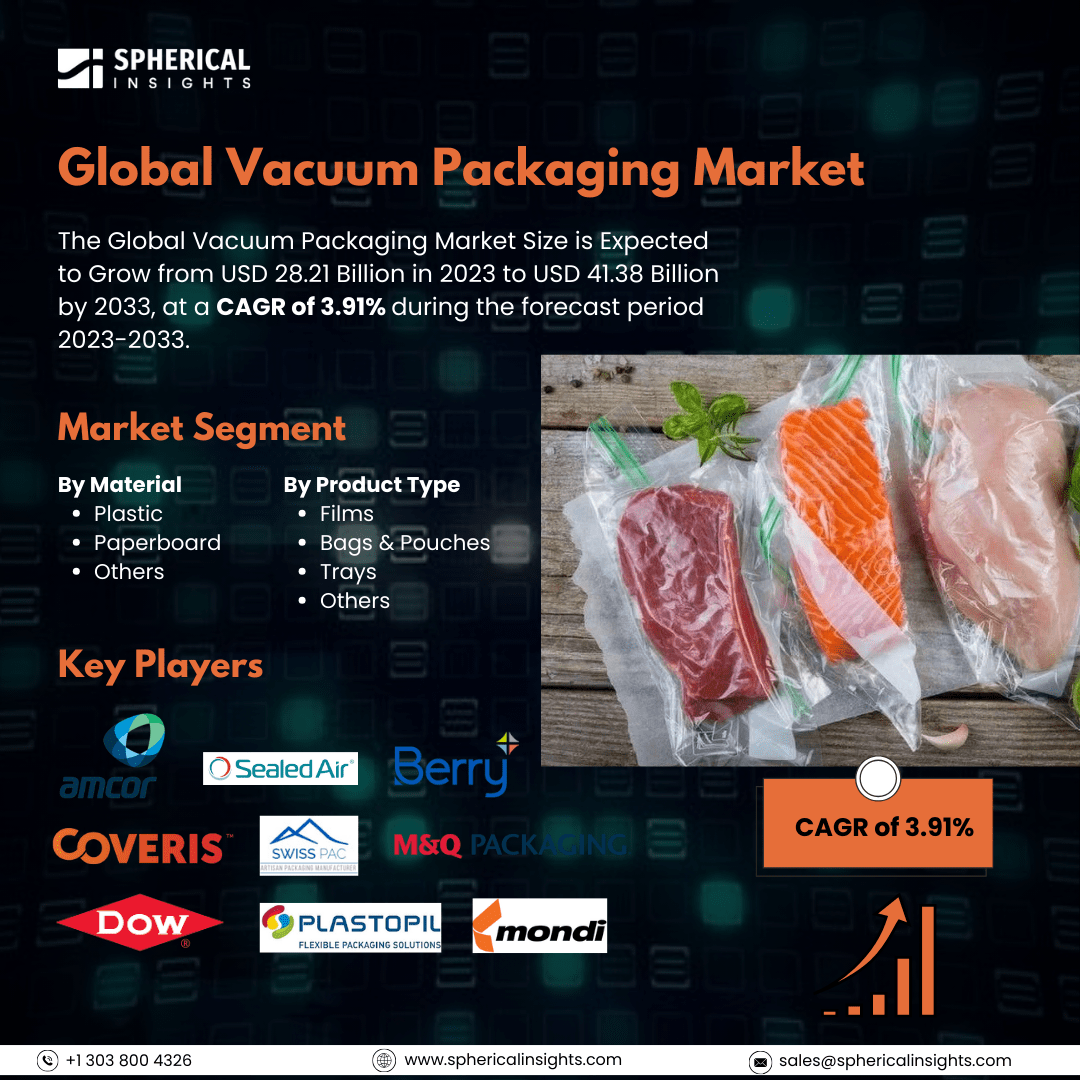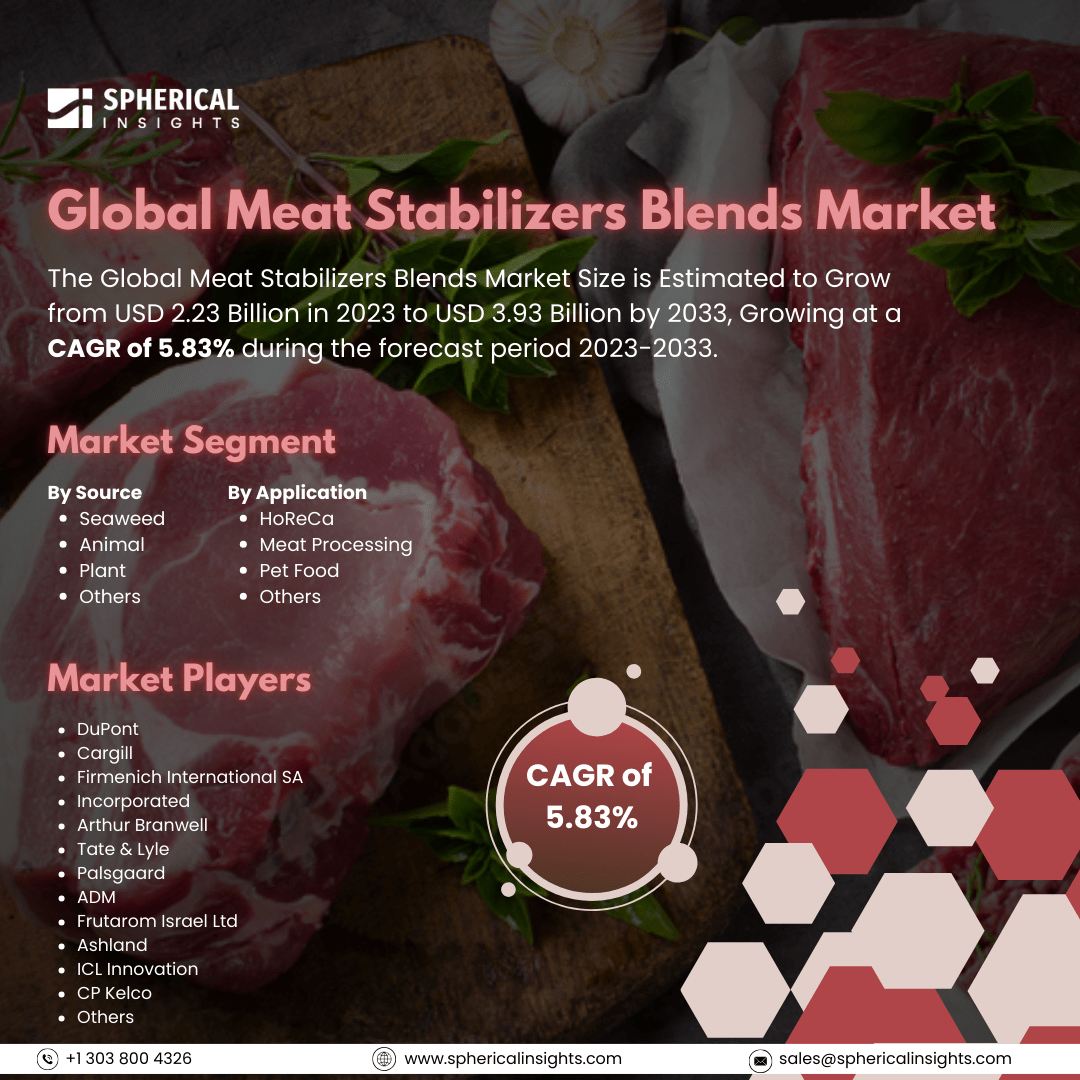Global Vacuum Packaging Market Size to worth USD 41.38 Billion by 2033
According to a research report published by Spherical Insights & Consulting, The Global Vacuum Packaging Market Size is Expected to Grow from USD 28.21 Billion in 2023 to USD 41.38 Billion by 2033, at a CAGR of 3.91% during the forecast period 2023-2033.
Browse key industry insights spread across 210 pages with 110 Market data tables and figures & charts from the report on the Global Vacuum Packaging Market Size, Share, and COVID-19 Impact Analysis, By Material (Plastic, Paperboard, and Others), By Product Type (Films, Bags & Pouches, Trays, and Others), and By Region (North America, Europe, Asia-Pacific, Latin America, Middle East, and Africa), Analysis and Forecast 2023 – 2033.
The vacuum packaging Market refers to the process of packaging when the air inside a package is removed to extend its shelf life, mainly applied to foods, pharmaceutical products, and consumer products. This is referred to as sealing in a vacuum-tight container that removes air that causes spoilage and degradation. Vacuum packaging is used for perishable foods, pharmaceuticals, and electronics on large scales to ensure product freshness, reduce waste, and offer convenience for storage and transport. The growth in the market is driven by increasing demand for convenient, long-lasting, and portable packaging solutions. Increasing consumer preference for ready-to-eat meals, packaged food, and organic products, which need preservation over a long period, contributes significantly to market expansion. Advances in packaging technology, such as improved barrier properties and sustainable materials, support the growing need for vacuum packaging solutions. However, the market does face some challenges. The cost of high-end packaging machinery and materials is likely to restrict the use of vacuum packaging by small and medium enterprises.
The plastic segment accounted for the largest share in 2023 and is expected to grow at a significant CAGR during the forecast period.
Based on the material, the vacuum packaging market is classified into plastic, paperboard, and others. Among these, the plastic segment accounted for the largest share in 2023 and is expected to grow at a significant CAGR during the forecast period. Plastic materials, such as polyethylene, polypropylene, and polyvinyl chloride, are widely used due to their flexibility, lightweight nature, and ability to provide a strong barrier against moisture, oxygen, and contaminants. This makes plastic ideal for vacuum packaging, especially in the food industry, where preservation of freshness and quality is critical.
The bags & pouches segment accounted for the largest share in 2023 and is expected to grow at a significant CAGR during the forecast period.
Based on the product type, the vacuum packaging market is divided into films, bags & pouches, trays, and others. Among these, the bags & pouches segment accounted for the largest share in 2023 and is expected to grow at a significant CAGR during the forecast period. Bags and pouches are widely used across various industries, particularly in food packaging, due to their excellent ability to preserve the quality and shelf life of products by providing an airtight seal. This category includes flexible packaging solutions made from materials such as polyethylene, polypropylene, and multi-layered films, which are ideal for a range of food products like meat, cheese, and snacks.
North America is estimated to hold the largest vacuum packaging market share over the forecast period.
North America is estimated to hold the largest vacuum packaging market share over the forecast period. Technological advancements, like vacuum packaging, are at the forefront in the region, and thus, they boost the growth of the market. Moreover, the increasing demand for dairy products has increased the need for vacuum skin packaging films and bags, which further fuels the growth of the regional market. For example, according to the U.S. Department of Agriculture (USDA), in 2022, the consumption of dairy products rose to 653 pounds per capita, with cheese consumption reaching an all-time high at 42 pounds per capita.
Asia Pacific is predicted to have the fastest CAGR growth in the vacuum packaging market over the forecast period. The growing meat & dairy industry in the region is a major contributor to the regional market's growth. Meat consumption in the region is rising due to factors, such as higher income and dietary changes. According to Nikkei Asia, Asia Pacific is projected to account for 52% of the global meat trade by 2030, further aiding the market's growth in the region.
Company Profiling
Major key players in the vacuum packaging market are Amcor Limited, Sealed Air Corporation, Berry Global Inc., Coveris Holdings SA, and Swiss Pac Pvt. Ltd, M&Q Packaging LLC, Dow Inc., Klockner Pentaplast Group, Plastopil Ltd, and Mondi Group.
Key Target Audience
- Market Players
- Investors
- End-users
- Government Authorities
- Consulting And Research Firm
- Venture capitalists
- Value-Added Resellers (VARs)
Recent Development
- In November 2023, Coveris Holdings SA announced the commercial launch of recyclable monoflex thermoform packaging film. The high-performance mono-material that is developed provides the films of the thermoforms. They deliver the carbon footprint reduction goal as well as apply it as a food sector vacuum product.
Market Segment
This study forecasts global, regional, and country revenue from 2023 to 2033. Spherical Insights has segmented the vacuum packaging market based on the below-mentioned segments:
Global Vacuum Packaging Market, By Material
- Plastic
- Paperboard
- Others
Global Vacuum Packaging Market, By Product Type
- Films
- Bags & Pouches
- Trays
- Others
Global Vacuum Packaging Market, By Regional Analysis
- North America
- Europe
- Germany
- UK
- France
- Italy
- Spain
- Russia
- Rest of Europe
- Asia Pacific
- China
- Japan
- India
- South Korea
- Australia
- Rest of Asia Pacific
- South America
- Brazil
- Argentina
- Rest of South America
- Middle East & Africa
- UAE
- Saudi Arabia
- Qatar
- South Africa
- Rest of the Middle East & Africa



